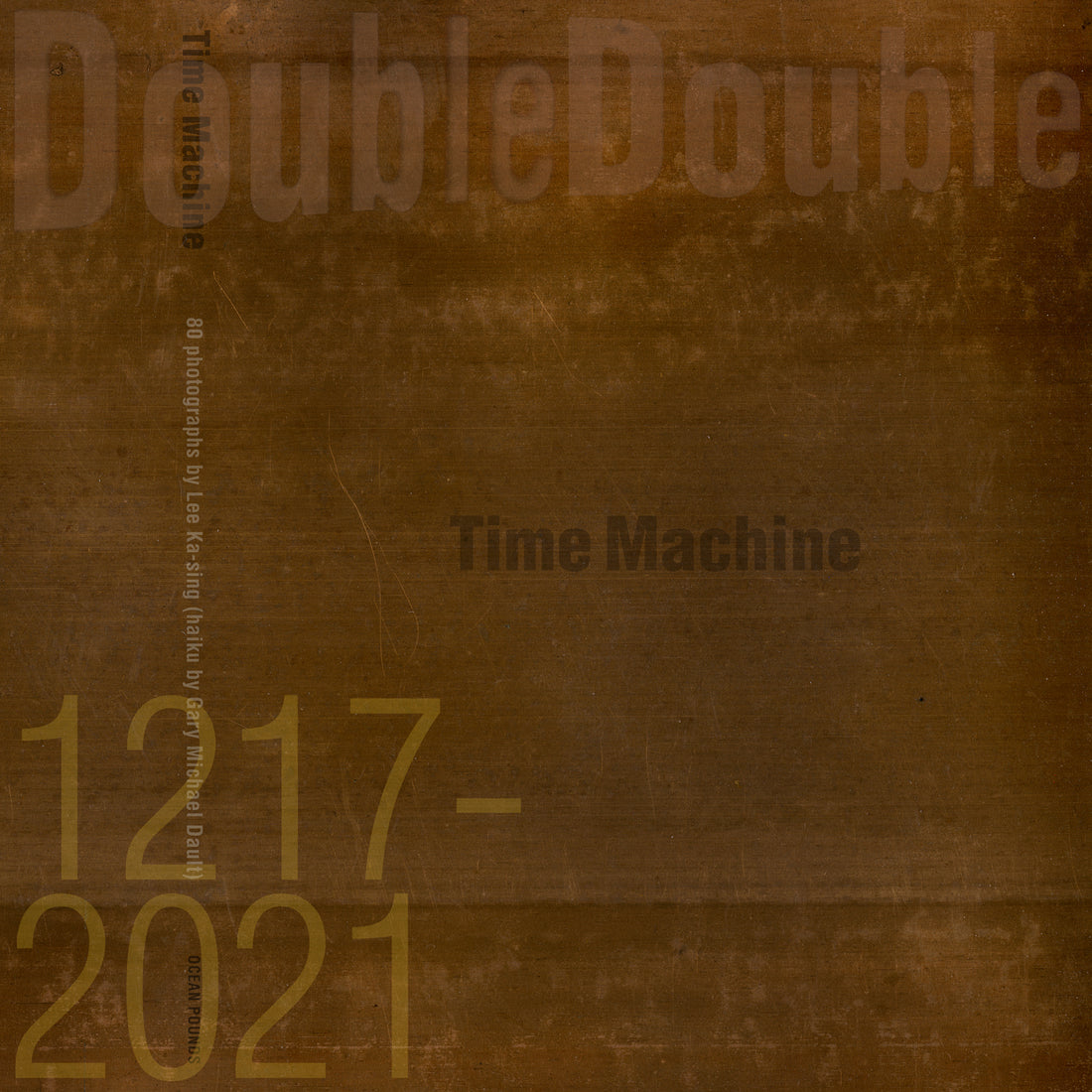
DOUBLE DOUBLE
A Holly Lee and Lee Ka-sing online magazine
Published on Fridays since January 2019
李家昇黃楚喬網上雜誌,逢星期五出版
Writings/ Photographs/ Poetry/ Archives
++++++++++++++++++++++++++
JUNGLE LINE
Image, words, and the indefatigable imagination of Time Machine
written by Holly Lee
The Time Machine described in H. G. Wells' 1895 novel was a mechanism, a metallic framework constructed out of nickel, ivory, wired by intricate networks of crystalline quartz bars. It was a fictional instrument invented to achieve travel - forward or backward through time. For many years the term Time Machine has been used recurrently in literature, films and television, songs and music, and to recent memory, a discontinued roller coaster at Freestyle Music Park in Myrtle Beach, South Carolina; a backup utility for macOS; a 2016 VR simulation video game by Minority Media. A train of thought comes to me when I think about Lee Ka-sing's book, which has adopted TIME MACHINE as its title. Was he thinking of using his images to travel across time? If so, where is he taking us and are there many stops, a destination, or is it just a loop with no beginning and no end? One way or the other I could imagine him saying,"the beginning is the end is the beginning...", giving me that mischievous, inconclusive; a blue, prime smile.

The cover of TIME MACHINE is a photograph of a thin copper sheet Ka-sing bought eons ago. He had always wanted to make a pin-hole camera, travel through time and look into infinity through a tiny hole.
Since 2015, Lee Ka-sing has been working on the TIME MACHINE series intermittently, harvesting hundreds of black and white images, primarily of objects; others, the minutiae of unimportant gatherings. As early as 2015, he had invited Gary Michael Dault, a Toronto painter and writer, to participate in the project. Gary would select certain images from the body of work, and produce a haiku for each. Every now and then some of the collaborated pieces were shown online. The meeting of the two minds has aroused curious interplays between words and images, and this continues to develop and flower up to this day, in 2021.
I have the privilege and first-hand knowledge to familiarize myself with the ongoing process of the TIME MACHINE collaboration between the two artists. Always wanted to read it as a book; I thought it would be wonderful to gather the digital pieces scattered here and there, and shape it into a publication - something that I can have control over the pages, turn and pause at will, settle my eyes as I would like on the poem, or on the image. I do not doubt the wish would come true one day, but feel awfully excited it could be accomplished so soon.
To me, reading Lee's TIME MACHINE is not unlike watching a sci-fi movie. I have incorporated, unawarely sound, and music into each pulsating, mute yet illuminating object floating in deep space. Scanning from image to haiku, back and forth, in between visuals and words, I have thrown myself further into the fourth dimension - in time, in a space of disarrayed timelines, where many things happen and collide. My initial impression of the image "hope" was general: a transparent globe hovering over nebulous clouds, its lucidity clear as day, quickly disquieted by the ensuing fragility. Could it be a doubt? In the sinuous trail of his mind Gary echoed in the opposite page by the haiku "Careful careful". My further examining of "hope" brings me back to another thing - a teapot, and a time in the 90s, when Ka-sing bought this teapot, branded Mono fillo and designed by Tassilo V. Grolman from Berlin. He broke the teapot at some point and it was never used again. This piece of history, however, slipped into his picture - in an entirely new bearing and context. He called it hope. In response to its delicate and brittle nature, Gary was unapologetic in jotting down a haiku of mild reproach:
Careful careful
hope is hoisted
into view
a monstrous invitation
In another photograph of a thick book, Lee called it simply "book", but Gary relates it to Leviathan - the legendary sea serpent. And indeed, a giant lovely monster it is. Not indicated in the picture, the mammoth is in fact a huge book of Leonardo da Vinci, measuring 450mmx 300mm x 70mm published by Taschen.
Leviathan
the book a whale
carrying a text
to the deeps
Reading the images and texts in parallel, one is not only drawn to a wealth of magnetic and enigmatic photographs, but also to an explosion of imageries through the mouth of a poet. In processing this material, inevitably, I am also traveling in time - pondering my past, mulling over personal or collective memories of bygone moments. Thus I remember Leviathan not merely being a sea monster in Jewish mythology, but also the name of a 2012 documentary film about the brutal reality of industrial fishing. At the same time, I connect "book" to a whale instantly, because the object in the photograph does resemble the sperm whale I saw in a film, whose oversized flat nose made up a third of its body, and dived as deep as 6,000 feet under the sea. Looking at the image, I can almost hear the powerful clicks it produced in the ocean, and in a flash I am being carried back again down the deeps, swung back sharply to a near drowning experience many summers ago, when I was still a teenager. Such is the power of image, of words, and our Indefatigable imagination.
Aristotle's idea of time is constantly related to motion, a continuum of pre and post connecting indivisible moments. In The Museum of Innocence, Istanbul Orhan Pamuk carried that notion further and inscribed a time spiral on the floor of the entrance hall. This would lead us to the timepieces, a clock exhibition called "Time" on the first floor. We were at Pamuk's museum a few years ago where we encountered the time spiral and walked up those stairs. Lee admits that he has always been fascinated by the circle. Years ago, when in New York, he was excited to find Duchamp's Rotoreliefs Optical Discs, a replica at MOMA's bookstore, mesmerized by the motion and illusionary space they could create. If he was able to build a real machine of time, I imagine, it would be something like the Rotary Glass Plates (a work Duchamp made in 1920), full of motion and optical illusion, freeing himself from the narrowness of present moments. Instead, he built his TIME MACHINE upon images, mostly of objects. Like Duchamp's readymade: underwood typewriter cover (1916), a philosophical study of an object so remarkable at that time, Lee produces images to study personal objects, one at a time, unlocking its mystery, its journey, and the nonlinear unfolding of associated memories and ideas. In TIME MACHINE he calls together all his favourite things: poetry, art, remembrances, mirages, his reverie of getting there; a wheel, a cup, a performer, a tent; the treachery of images, the wing and the song.






TIME MACHINE
80 photographs by Lee Ka-sing, haiku by Gary Michael Dault
isbn: 9781989845202
8x10 inch, 180 pages, softcover, perfect binding, published by OCEAN POUNDS.
CAD$75 (plus tax, shipping)
This book is available for direct order from BLURB
https://www.blurb.ca/b/10947020-time-machine
The book is also available in ebook version
(for desktop, iPad, Android devices or Kindle)
download. US$4.99
https://www.blurb.com/ebooks/768631-time-machine
(About TM series) The earliest piece in TIME MACHINE was made in 2015, whereas most photographs included in this book were created between 2017 to 2019. The original idea was a series of visual studies on objects, photographed with a lens I seldom used, in a minimal way and with least sentimental elements added to it. All I used was existing light. The photograph was completed in a seven and a half inch square, surface mounted on spruce stained in black, with a thickness of one and half inch. An acrylic gel medium was applied as an adhesive agent as well as protection for the surface. The photograph thus became a piece of object. In the larger context I regrouped them organically, and used these individual pieces as vocabularies, or phrases to form a piece of narrative. A selection of photographs were included in the Hong Kong and Toronto exhibitions. I have also collaborated with Gary Michael Dault on some of the work from this series, in which he wrote haiku after the photograph. It has provided a new reading, or another layer to the work. (Lee Ka-sing)
++++++++++++++++++++++++++
DOUBLE DOUBLE
Issue 1217-2021
A Holly Lee and Lee Ka-sing online magazine. Published on Fridays since January 2019. Published by OCEAN POUNDS and archived at oceanpounds.com
All rights Reserved.
Click here to subscribe
If you are a researcher or writer and want to use the material, please write us in advance. Some of the materials might have different level of copyrights involved.
DOUBLE DOUBLE archives
https://oceanpounds.com/blogs/doubledouble
Holly and Ka-sing currently live in Toronto with their daughter Iris, and their cat Sukimoto. Contact with email at - mail@leekasing.com / holly@xpecial.com
++++++++++++++++++++++++++

